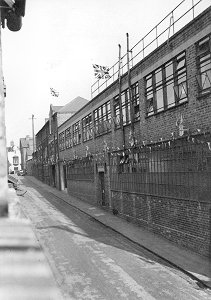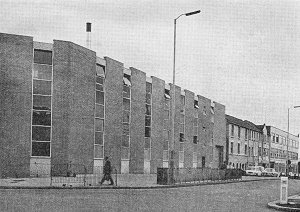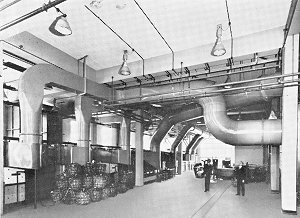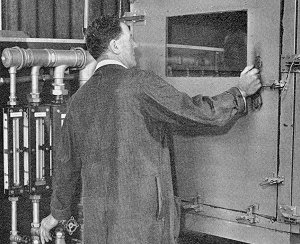6. The Works
Soon after the war of 1939-45 it was a time to rebuild shattered
cities.
Plymouth, Coventry, Bristol, Liverpool, many others too had
received the attention of the Luftwaffe over the war years.
Everything that was not needed for the war effort was now in
short supply. Houses
were scarce, with returning service men and women having to share an
already crowded household.
Gibbons were now in a position to take the advantage of producing
builder’s hardware. So
the fifties, sixties and early seventies saw the demolition of much
of the old factory.
 |
The factory (decorated
for the Coronation in 1953), looking up Church Lane to the
Birmingham New Road. On the right was a row of small
cottages most of which had become small workshops. At
the top of Church Lane, just before some shops, some of
these had been acquired by Gibbons and was turned into the
Art Metal Department. |
| The Main Gate (decorated
for the Coronation). The Time Office is on the left.
Later it was moved across to the right and the vacated Time
Office became the First Aid Department. |
 |
The old back to back cottages, that had been in use as workshops,
and "Fox's warehouse" were built over.
The name Fox's warehouse was from the old chap who had been
in charge for so many years.
Harry Fox lived on by name long after he passed away.
During the demolition long hand-forged nails, that had held
the beams together, were found all over the place, some as long as
nine inches with a forged twist in them for extra hold, coins and
bits of long years of forgotten patterns were found, then thrown
away as scrap.
The large retail complex of St Johns Retail Park now stands on the
site of this once proud business, whose products, with those of
other long gone factories, made Wolverhampton famous. Just a small
part still exists at the bottom of what was once Nelson Street.
This was the transport and despatch department, once the
domain of one Harry Sharples, the manager, who worked all of his
life for Gibbons. This last part of the factory complex was known as Star Works
as it was the birth place of the “Star” motor car, another product
of class and pride from the area, and now pictured on a nearby wall.
Soon an extra floor of offices was erected over the frontages of
Church Lane, then a second floor, then the last of the development:
a massive plating and anodizing shop on the corner of Church Lane
and the Birmingham New Road.
The new ring road saw the facade of James Gibbons come into
prominence as the old houses and small industrial units, including
the Art Metal Department, were demolished.
 |
The plating and
anodizing shop, on the corner of what had become the Ring
Road and Birmingham New Road. St. John's Retail Park, now stands on this site. |
| The interior of the new
anodizing plant, 1970. The shop had vats 17 feet long, 2
feet 6 inches wide and 7 feet deep, to treat large sections
of aluminium window walling.
A new plating shop was opened the
next year.
|
 |
 |
All sorts of specialised
equipment was needed for the wide range of Gibbons products.
This is a test rig which simulated gales of up to 90 mph, to test
the effect of wind and rain on Gibbons' windows. |
Fortunately a photograph, assembled from two parts, was taken of the
factory from the top of St John’s Church.
A great part of the area around and beyond is revealed in
this most important picture of what was once Britain’s oldest lock
factory, which had had its tri-centenary celebrations many years
before it eventually closed and the area was re-developed.

There is an interesting story that showed the ineptitude of the
local council. Between
the factory in Church Lane ran other factories and units.
In Nelson Street gates were erected at both ends during the
war, though opened each day as a right of way.
Soon the street was incorporated into the factory complex as
Gibbons purchased the small factories on the right of the road and
developed service units across the street until it was all Gibbons,
with no one noticing that Wolverhampton had lost a Street. All of
this area is now the St John’s Retail Park bordering on the Ring
Road.
|